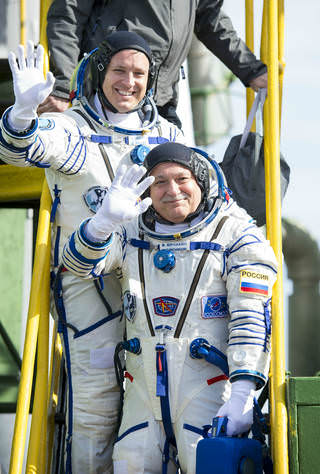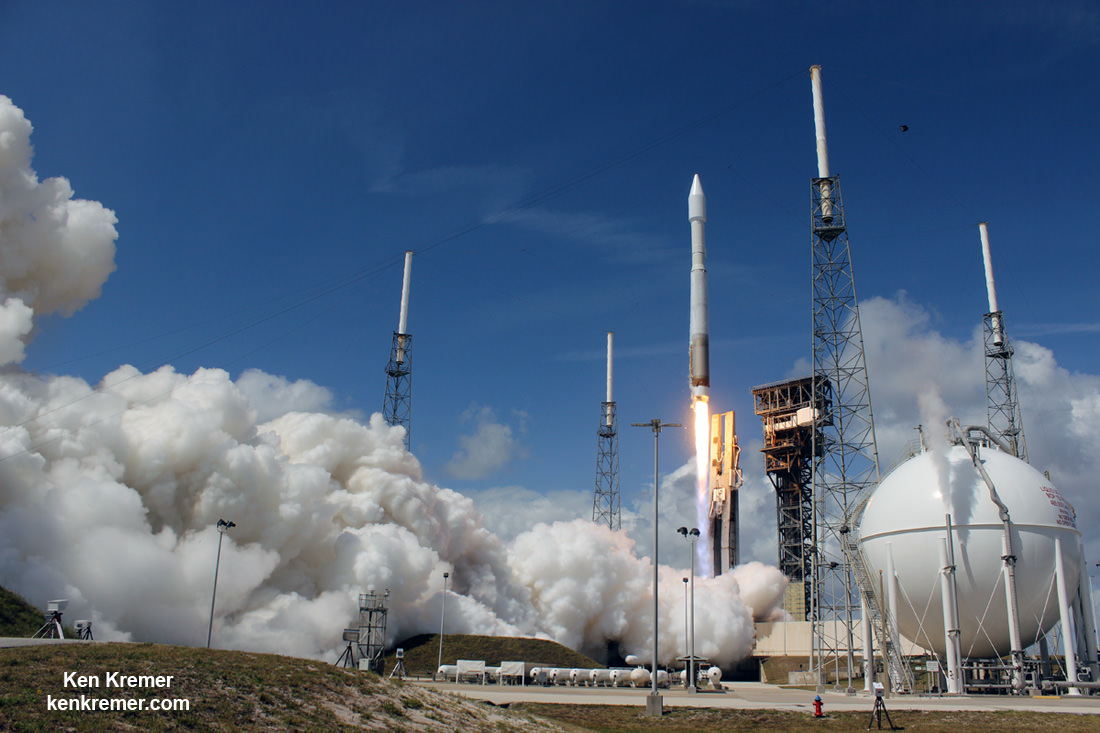
The Soyuz MS-04 rocket launches from the Baikonur Cosmodrome in Kazakhstan April 20, 2017, carrying Expedition 51 Soyuz Commander Fyodor Yurchikhin of Roscosmos and Flight Engineer Jack Fischer of NASA into orbit to begin their four and a half month mission on the International Space Station. Credits: NASA/Aubrey Gemignani
KENNEDY SPACE CENTER, FL - A new Russian/American duo has arrived at the International Space Station this morning, April 20, after a six-hour flight following their successful launch aboard a Russian Soyuz capsule on a fast track trajectory to the orbiting outpost.
The two person international crew comprising NASA astronaut Jack Fischer and cosmonaut Fyodor Yurchikhin of the Russian space agency Roscosmos launched aboard a Russian Soyuz MS-04 spacecraft from the Baikonur Cosmodrome in Kazakhstan at 3:13 a.m. (1:13 p.m. Baikonur time).
After orbiting the Earth just four times on a planned accelerated trajectory they reached the station six hours later and safely docked at the station at 9:18 a.m. EDT.
"We have contact and capture confirmed at the space station at 9:18 am EDT," said the NASA Houston mission control commentator.
The station and Soyuz vehicles were flying some 250 mi (400 km) over the northern Atlantic at the time of docking.
The dynamic duo of Yurchikhin and Fischer join three Expedition 51 crew members already onboard - Expedition 51 Commander Peggy Whitson of NASA and Flight Engineers Oleg Novitskiy of Roscosmos and Thomas Pesquet of ESA (European Space Agency).
Thus the overall station crew complement of astronauts and cosmonauts increases to five - from the US, Russia and France - representing their respective space agencies and countries.
Jack Fisher is a rookie space flyer whereas Yurchikhin is an accomplished veteran on this his 5th mission to orbit.

Expedition 51 Soyuz Commander Fyodor Yurchikhin of Roscosmos and Flight Engineer Jack Fischer of NASA wave farewell prior to boarding the Soyuz MS-04 spacecraft for launch April 20, 2017, at the Baikonur Cosmodrome in Kazakhstan. Credits: NASA/Aubrey Gemignani
Prior to docking the crew accomplished an approximately 10 min flyaround inside the Soyuz shortly before sunrise and beautyfully backdropped by earth towards the end at a distance of roughly several hundred meters away.
All Soyuz systems performed as planned for what was an entirely automated rendezvous and docking using the Russian KURS docking system. The crew could have intervened if needed.
The new pair of Expedition 51 crew members will spend about four and a half months aboard the station during their increment.
They will be very busy conducting approximately 250 science investigations in fields such as biology, Earth science, human research, physical sciences and technology development.
And there will be no time to rest! Because this week's just launched unpiloted 'SS John Glenn' Cygnus resupply ship is eagerly awaiting its chance to join the station and deliver nearly 4 tons of science experiment, gear and crew provisions to stock the station and further enhance its research output.
Orbital ATK's seventh Cygnus cargo delivery flight to the station - dubbed OA-7 or CRS-7 - launched at 11:11 a.m. EDT Tuesday, April 18 atop a United Launch Alliance Atlas V rocket from Space Launch Complex 41 on Cape Canaveral Air Force Station in Florida.

Orbital ATK's seventh cargo delivery flight to the International Space Station -in tribute to John Glenn- launched at 11:11 a.m. EDT April 18, 2017, on a United Launch Alliance Atlas V rocket from Space Launch Complex 41 on Cape Canaveral Air Force Station in Florida. Credit: Ken Kremer/kenkremer.com
The SS John Glenn is expected to arrive at the station early Saturday morning on April 22.
Expedition 51 astronauts Thomas Pesquet of ESA and Peggy Whitson of NASA will use the space station's Canadian-built robotic arm to grapple Cygnus, about 6:05 a.m. Saturday.
They will use the arm to maneuver and berth the unmanned vehicle to the Node-1 Earth-facing nadir port on the Unity module.
"Investigations arriving will include an antibody investigation that could increase the effectiveness of chemotherapy drugs for cancer treatment and an advanced plant habitat for studying plant physiology and growth of fresh food in space," says NASA.
"Another new investigation bound for the U.S. National Laboratory will look at using magnetized cells and tools to make it easier to handle cells and cultures, and improve the reproducibility of experiments. Cygnus also is carrying 38 CubeSats, including many built by university students from around the world, as part of the QB50 program. The CubeSats are scheduled to deploy from either the spacecraft or space station in the coming months."
Cygnus will remain at the space station for about 85 days until July before its destructive reentry into Earth's atmosphere, disposing of several thousand pounds of trash.
Watch for Ken's onsite launch reports direct from the Kennedy Space Center in Florida.
Stay tuned here for Ken's continuing Earth and Planetary science and human spaceflight news.
Ken Kremer
No comments:
Post a Comment